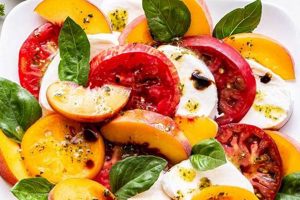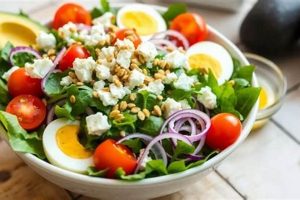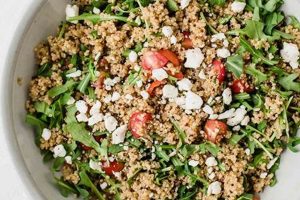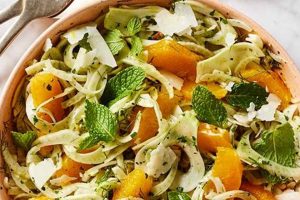Dishes featuring chilled, often sliced or shredded, beef combined with various vegetables, herbs, and a flavorful dressing constitute a broad culinary category. A “Thai Beef Salad” with its spicy lime dressing, or a Vietnamese-style “B L Lt” salad showcasing grilled beef in betel leaves exemplify this diversity. These preparations can range from light and refreshing summer meals to more substantial, protein-rich options.
The versatility of these dishes contributes to their widespread popularity. They offer a balance of nutrients, combining the protein of beef with the vitamins and fiber from fresh produce. Historically, preserving meat through drying or smoking allowed for its incorporation into salads, extending its usability and providing sustenance across seasons. The evolution of culinary techniques and the increasing availability of fresh ingredients have further elevated these dishes, transforming them into celebrated components of diverse cuisines worldwide.
Exploring specific regional variations, examining the nutritional profiles of different ingredients, and providing detailed instructions for preparation will offer a comprehensive understanding of this culinary art form.
Tips for Crafting Exceptional Beef Salads
Achieving a well-balanced and flavorful salad requires careful consideration of ingredient selection and preparation techniques. The following tips offer guidance for creating dishes that highlight the versatility and nutritional value of beef.
Tip 1: Select High-Quality Beef: Opting for lean cuts, such as sirloin, flank steak, or tenderloin, ensures optimal texture and flavor. Grass-fed beef offers a distinct, richer taste.
Tip 2: Marinades Enhance Flavor: Marinating the beef prior to cooking infuses it with deeper flavor profiles. Asian-inspired marinades often utilize soy sauce, ginger, and garlic, while Mediterranean versions might incorporate lemon, herbs, and olive oil.
Tip 3: Proper Cooking Techniques are Essential: Whether grilling, pan-searing, or broiling, achieving the desired level of doneness is crucial. Overcooking can result in tough, dry meat, while undercooking may pose health risks.
Tip 4: Slicing Technique Impacts Texture: Slicing the beef thinly against the grain ensures tenderness. For salads featuring seared or grilled beef, allowing the meat to rest before slicing helps retain its juices.
Tip 5: Balance Flavors and Textures: Consider the interplay of ingredients. Crunchy vegetables, such as carrots, cucumbers, and bell peppers, complement the tender beef. Adding nuts or seeds provides textural contrast and enhances the nutritional value.
Tip 6: Dressings Bring It All Together: The dressing serves as a unifying element. Vinaigrettes, creamy dressings, and Asian-inspired sauces each contribute distinct flavor profiles. The intensity of the dressing should complement the other ingredients.
Tip 7: Fresh Herbs Elevate the Dish: Incorporating fresh herbs, such as mint, cilantro, basil, or parsley, provides aromatic complexity and visual appeal. Adding herbs just before serving preserves their vibrancy.
By adhering to these guidelines, one can consistently create flavorful and satisfying salads that showcase the culinary potential of beef.
These insights provide a foundation for crafting exceptional beef salads. The subsequent sections will delve into specific recipes and explore variations within this diverse culinary category.
1. Beef Selection (Cut, Quality)
Beef selection significantly influences the final outcome of any beef salad recipe. Choosing the appropriate cut and prioritizing quality ensures optimal flavor, texture, and overall enjoyment. Understanding the nuances of various beef cuts and their suitability for salads is paramount to culinary success.
- Cut
Different cuts offer varying levels of tenderness and flavor. Tender cuts like tenderloin, sirloin, or flank steak are generally preferred for salads as they require less cooking time and are easily sliced. Tougher cuts, such as chuck or brisket, are less suitable due to their longer cooking times and potential for dryness when served cold.
- Quality
The quality of beef directly impacts the salad’s flavor profile. Higher-quality beef, often indicated by marbling and grading, typically possesses a richer, more robust taste. Grass-fed beef offers a distinct flavor profile compared to grain-fed options. Selecting quality beef elevates the overall dining experience.
- Fat Content
The fat content of the chosen cut influences both texture and flavor. Leaner cuts contribute to a lighter, more refreshing salad, while cuts with higher fat content offer a richer, more decadent experience. Balancing fat content with other salad components is essential for achieving a harmonious flavor profile.
- Preparation Method
The chosen cooking method influences the ideal beef cut selection. Grilling benefits from well-marbled cuts that retain moisture at higher temperatures. Thinly sliced cuts like flank steak are well-suited for stir-frying, while tenderloin excels when seared or quickly pan-fried. Aligning cut and cooking method ensures optimal results.
Careful consideration of these facets of beef selection ensures a successful and satisfying beef salad. The interplay between cut, quality, fat content, and preparation method ultimately dictates the final flavor and texture of the dish, highlighting the importance of informed beef selection in recipe execution.
2. Marinade
Marinades play a crucial role in beef salad recipes, contributing significantly to the final flavor profile and texture of the beef. The chemical interaction between the marinade’s components and the beef’s proteins results in enhanced tenderness and flavor infusion. A marinade typically comprises three key elements: an acid, an oil, and flavoring agents. The acid, often citrus juice or vinegar, helps break down tough muscle fibers, tenderizing the beef. The oil acts as a flavor carrier and helps retain moisture during cooking. Flavoring agents, such as herbs, spices, garlic, and ginger, impart distinct tastes and aromas. For instance, a Korean-inspired beef salad might utilize a marinade with soy sauce, sesame oil, ginger, and garlic, creating a savory and umami-rich flavor profile. Conversely, a Southeast Asian-inspired salad might incorporate fish sauce, lime juice, lemongrass, and chili, resulting in a tangy and spicy flavor profile.
The duration of marination also impacts the final result. While short marinades (30 minutes to 2 hours) primarily enhance surface flavors, longer marinades (4 to 24 hours) allow for deeper penetration and more pronounced flavor infusion. However, excessively long marinades, especially those with high acid content, can negatively impact the texture, making the beef mushy. The choice of marinade should align with the desired flavor profile and the specific cut of beef used. Leaner cuts benefit from shorter marinades to prevent over-tenderization, while tougher cuts can withstand longer marinades to achieve optimal tenderness.
Understanding the function and impact of marinades is essential for crafting exceptional beef salads. Selecting appropriate ingredients and controlling marination time allows for precise flavor and texture control, contributing significantly to the overall culinary experience. Effective marinade selection elevates a simple beef salad from palatable to exceptional, demonstrating the practical significance of this culinary technique.
3. Vegetable Components
Vegetable components are integral to a successful beef salad recipe, contributing texture, flavor, and nutritional value. Their selection and preparation significantly influence the overall balance and appeal of the dish. The interplay between the chosen vegetables and the beef creates a complex sensory experience, elevating the salad beyond a simple protein source. Crunchy vegetables like cucumbers, bell peppers, and carrots offer textural contrast to the tender beef, while leafy greens like spinach or arugula provide a refreshing element. Furthermore, incorporating a variety of colorful vegetables enhances the visual appeal of the salad, making it more enticing.
Beyond textural and aesthetic contributions, vegetables introduce a diverse range of flavors. Sweet vegetables like roasted red peppers or caramelized onions can complement the savory beef, while peppery radishes or spicy jalapeos provide a contrasting bite. The choice of vegetables should complement the overall flavor profile of the salad, considering the marinade used for the beef and the intended dressing. For example, a Thai beef salad might incorporate shredded green papaya and carrots for a refreshing crunch, while a Mediterranean-style salad might include roasted vegetables like zucchini and eggplant. These choices not only enhance the flavor profile but also contribute essential vitamins and nutrients.
Careful consideration of vegetable components is essential for crafting a well-balanced and satisfying beef salad. Their inclusion offers more than mere garnish; they are crucial for achieving the desired texture, flavor, and nutritional balance. Understanding the interplay between the chosen vegetables and the other components of the salad, such as the beef and the dressing, allows for a more informed and nuanced approach to recipe development. This knowledge empowers culinary exploration and enhances the overall dining experience.
4. Dressing Choice
Dressing choice is a pivotal element in beef salad recipes, significantly influencing the final flavor profile and overall balance of the dish. The dressing acts as a unifying component, bringing together the disparate flavors of the beef, vegetables, and other ingredients. A well-chosen dressing complements and enhances the existing flavors, creating a harmonious and satisfying culinary experience. Conversely, an ill-suited dressing can overwhelm or clash with the other components, diminishing the overall enjoyment of the salad.
- Flavor Profile
The flavor profile of the dressing should complement the other ingredients in the salad. A vibrant, acidic vinaigrette might pair well with a grilled beef salad featuring fresh vegetables, while a creamy, richer dressing might complement a salad with seared beef and roasted vegetables. For example, a lime-based dressing with cilantro and chili would enhance a Southeast Asian-inspired beef salad, whereas a lemon-herb vinaigrette would suit a Mediterranean-style salad. Careful consideration of flavor profiles is crucial for achieving a balanced and cohesive dish.
- Texture and Consistency
The texture and consistency of the dressing also contribute to the overall sensory experience. A light vinaigrette adds a refreshing element, while a creamy dressing provides a richer mouthfeel. The consistency should also be considered in relation to the other ingredients. A thicker dressing might cling better to heartier vegetables, while a thinner dressing might be more suitable for delicate greens. The interplay between dressing texture and salad components contributes to the overall enjoyment of the dish.
- Acidity and Sweetness
Balancing acidity and sweetness within the dressing is essential for achieving a harmonious flavor profile. The right balance can cut through the richness of the beef and complement the flavors of the vegetables. For example, a vinaigrette with a balanced ratio of vinegar to oil and a touch of sweetness from honey or maple syrup can create a complex and satisfying flavor profile. The level of acidity and sweetness should be adjusted based on the other ingredients and the desired overall taste.
- Ingredient Compatibility
The ingredients within the dressing should complement both the beef and the chosen vegetables. Consider the existing flavors and how the dressing ingredients will interact with them. For instance, a dressing containing soy sauce, ginger, and garlic would harmonize well with Asian-inspired beef salads, while a dressing with Dijon mustard and herbs would complement a more classic European-style salad. Ensuring ingredient compatibility across all components of the salad is key to a successful dish.
Selecting the appropriate dressing elevates a beef salad from a simple combination of ingredients to a cohesive and flavorful culinary creation. By carefully considering the flavor profile, texture, acidity, sweetness, and ingredient compatibility, one can create a dressing that perfectly complements the beef and vegetables, resulting in a well-balanced and satisfying dining experience. The dressing choice acts as the final touch, bringing all the elements together in a harmonious and delicious way.
5. Preparation Method
Preparation methods significantly influence the final outcome of beef salad recipes. The chosen method directly impacts the beef’s texture, flavor, and overall integration with the other salad components. Understanding the nuances of various preparation methods allows for informed decisions that maximize the culinary potential of beef in a salad context. Several factors warrant consideration when selecting a preparation method, including the desired texture of the beef (e.g., seared, grilled, or shredded), the overall flavor profile of the salad, and the specific cut of beef used. For example, grilling imparts a smoky char and enhances the natural flavors of the beef, making it suitable for salads with robust flavor profiles. Conversely, thinly slicing and quickly stir-frying beef results in a tender texture well-suited for Asian-inspired salads. Furthermore, the chosen preparation method should complement the other ingredients in the salad. A delicate poached beef might pair well with a light and refreshing salad, while a seared and charred beef might complement a more substantial salad with roasted vegetables.
Different cuts of beef respond differently to various preparation methods. Tender cuts like tenderloin or sirloin benefit from quick cooking methods like grilling or searing, which preserve their tenderness and enhance their natural flavors. Tougher cuts like flank steak or skirt steak might require marinating and slower cooking methods to achieve optimal tenderness. Matching the preparation method to the specific cut of beef ensures optimal results. For instance, a flank steak marinated in a citrus-herb mixture and grilled to medium-rare offers a flavorful and tender addition to a summer salad. Alternatively, shredded slow-cooked beef, seasoned with aromatic spices, provides a hearty and satisfying element in a more substantial salad.
The preparation method acts as a bridge connecting the inherent qualities of the beef to the desired outcome within the salad context. Careful consideration of this aspect allows for precise control over the final texture and flavor of the beef, significantly contributing to the overall balance and enjoyment of the salad. A thorough understanding of various preparation methods and their impact on different beef cuts empowers culinary creativity and enhances the potential for crafting exceptional beef salads. Ignoring the nuances of preparation can result in a dish that falls short of its potential, highlighting the practical significance of this culinary element.
Frequently Asked Questions
This section addresses common inquiries regarding the preparation and enjoyment of beef salads.
Question 1: What are the best cuts of beef for salads?
Leaner cuts like sirloin, tenderloin, flank steak, and skirt steak are generally preferred for salads due to their tenderness and relatively quick cooking times. These cuts offer a pleasant texture when sliced thinly and can be easily incorporated into various salad styles.
Question 2: How can one prevent beef from becoming tough in a salad?
Preventing toughness involves careful attention to cooking time and temperature. Avoid overcooking, as this leads to dry, tough meat. Marinades also contribute to tenderness by breaking down muscle fibers. Additionally, slicing the beef thinly against the grain enhances its perceived tenderness.
Question 3: What types of dressings complement beef salads?
The ideal dressing depends on the overall flavor profile of the salad. Vinaigrettes, creamy dressings, and Asian-inspired sauces can all complement beef salads. Consider the other ingredients and aim for a balanced flavor profile. A vibrant vinaigrette might pair well with a grilled beef and fresh vegetable salad, while a creamy dressing might complement a salad with seared beef and roasted vegetables.
Question 4: How long can beef salad be stored safely?
Proper storage is crucial for food safety. Beef salad should be refrigerated promptly after preparation and consumed within three to four days. Ensure the salad is stored in an airtight container to maintain freshness and prevent bacterial growth. Discard any salad left at room temperature for more than two hours.
Question 5: Can beef salad be made ahead of time for a gathering?
Preparing components in advance can simplify serving. The beef can be cooked and sliced, vegetables chopped, and dressing prepared separately. Combine these elements just before serving to maintain optimal texture and prevent the salad from becoming soggy. Store the individual components in airtight containers in the refrigerator.
Question 6: How can one enhance the nutritional value of a beef salad?
Incorporating nutrient-rich ingredients boosts the overall nutritional value. Include a variety of colorful vegetables, nuts, seeds, and legumes. These additions contribute vitamins, minerals, fiber, and healthy fats. Consider using whole grains like quinoa or farro for added complex carbohydrates and fiber.
Understanding these common points of inquiry provides a foundation for creating and enjoying a wide array of beef salads.
The following section provides a collection of diverse beef salad recipes, demonstrating the versatility and adaptability of this culinary concept.
Beef Salad Recipe
Exploration of the multifaceted nature of beef salad recipes reveals the interplay of various culinary elements. From the careful selection of beef cuts and marinades to the thoughtful incorporation of vegetables and dressings, each component contributes to the final dish’s overall harmony. Preparation methods further influence texture and flavor, demonstrating the versatility of beef within this culinary context. Understanding these nuances allows for a more informed and creative approach to crafting satisfying and flavorful salads.
Culinary exploration extends beyond established recipes, encouraging experimentation and adaptation. The principles discussed herein provide a framework for personalized creations, empowering individuals to explore diverse flavor profiles and textures. The potential for innovation within the realm of beef salad recipes remains vast, offering a continuous opportunity for culinary discovery and enjoyment.






